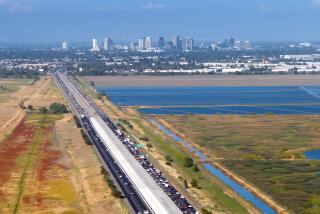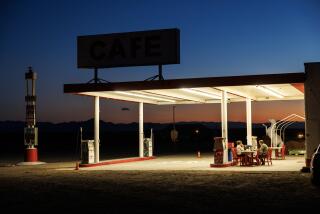Traffic Clogs Main Artery to Colorado Resorts
- Share via
VAIL, Colo. — David Castillo was puzzled: After being pulled over near Vail on Interstate 70, all he got was a warning ticket and a plea to slow down. No State Patrol. No sheriff in sight. Just a local cop.
For weeks, residents of this posh resort have been sending out Vail police to target drivers like Castillo. They are also air conditioning their homes, despite the cool mountain air, to help muffle the sound of vehicles roaring through the shoestring-thin Vail Valley.
The problem is that I-70 -- the main artery to the nation’s busiest ski resorts and a lifeline for tourist-dependent towns like Vail -- is becoming more congested every year. Hundreds of thousands of Colorado skiers, hikers, backpackers and families are vying with tourists to get to resort towns.
In Vail, where the average home costs more than $1 million, retreating from the hurly-burly of urban life is becoming much more difficult. Summit County Commissioner Gary Lindstrom, who spent 31 years in law enforcement, puts it this way: “The mountains have become an attractive nuisance.”
I-70 is an engineering marvel in places, winding its way through canyons and steep valleys deep into the heart of the Colorado Rockies. It climbs approximately a mile between mile-high Denver and the Eisenhower Tunnel, where it knifes under the Continental Divide.
In 1985, about 15,000 vehicles passed through the tunnel every day. In 2001, the number had risen to 28,000 and planners predicted there would be a daily average of 41,200 by 2025 and 63,000 on Saturdays.
A number of ski areas are within minutes -- and sometimes eyesight -- of the interstate, including Loveland, Keystone, Copper Mountain and Vail. Winter Park and Breckenridge depend heavily on I-70, and so do farther-flung resorts such as Steamboat Springs and Aspen.
All of them feel the pain when things go wrong.
An overturned tanker or string of SUVS and cars bowled over in a blizzard can block the four-lane highway for hours. An avalanche can close it for days. In several stretches, there is no frontage road to use to get around in the narrow mountain canyons.
Stop-and-go traffic is not uncommon on Sunday afternoons during the ski season or busy summer holiday weekends. It is a pain for resort-bound tourists and no bundle of joy for people who live along the highway.
“I-70 is our Main Street. People can’t get to their jobs serving the people who are stuck. You can’t get from one end of the county to the other,” said Harry Dale, a Clear Creek County commissioner.
Vail Mayor Rod Slifer, a real estate developer, came to Vail in 1962 when the first chairlift was being built and the only road to Denver, 100 miles away, was a blizzard-prone, two-lane highway over 11,992-foot-high Loveland Pass. He said he worried about the viability of Vail and other Colorado resorts along I-70.
“In 15 or 20 years I think the situation will be untenable,” he said, fearing tourists would go to areas where getting there wasn’t such a hassle.
It took years and hundreds of millions of dollars to ease I-70 congestion in Glenwood Canyon, west of Vail. Slifer and other community leaders along the interstate believe trying to add more lanes between the resorts and Denver isn’t the answer.
“They don’t have the money to build a beautiful highway to accommodate our historic towns like they did with Glenwood Canyon,” said Clear Creek County Commissioner Jo Ann Sorenson.
Added Lindstrom, her counterpart in Summit County: “We need a mass transit system that doesn’t involve tires or fossil fuels. We’ve reached critical mass.”
But building a train or monorail along the I-70 corridor would cost $7 billion to $8 billion, said Tom Norton, executive director of the Colorado Department of Transportation. He says the state doesn’t have the minimum amount of money needed to support a request for federal funding for such a project, and isn’t likely to in the near future.
Voters have already rejected a proposal to fund a study of a train. The transportation agency is endorsing two more lanes and high-speed bus service to ease traffic concerns.
Lindstrom said cheap bus service had already been tried and few people used it. “It’s not sexy. It’s a social thing. With a train you could have a club car where people would mix,” he said.
There has also been talk of banning trucks during busy weekends. But that could choke off supplies for rapidly growing mountain towns; a March 2003 blizzard shut down the interstate for days, leaving stores and restaurants short of food and beverages.
State Patrol Capt. Ron Prater said truck traffic had increased dramatically because of the needs of the mountain towns. The sale of discounted ski season passes also has increased winter traffic.
Which has Vail residents practically plugging their ears. This summer, the Vail Valley Foundation will employ a consultant to try to limit the impact of noise on outdoor orchestra concerts.
Not that drivers like Castillo are sympathetic.
“Nobody wants noise around their house, but what do you expect when you build a highway right next to a city?” Castillo said.
More to Read
Sign up for Essential California
The most important California stories and recommendations in your inbox every morning.
You may occasionally receive promotional content from the Los Angeles Times.










